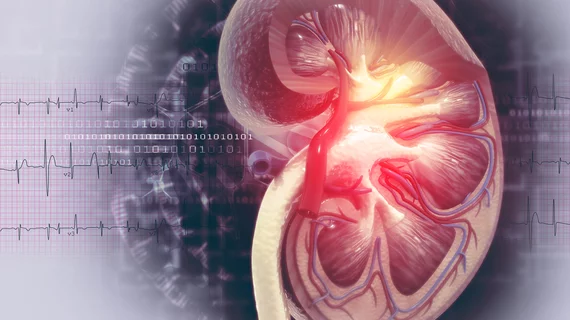How AI can improve care, limit unnecessary surgeries for patients with kidney tumors
Machine learning-based CT texture analysis can help with the evaluation of solid renal masses, according to new findings published in Academic Radiology. Could this help reduce the number of patients undergoing unnecessary surgeries?
Specialists typically assume solid renal masses are malignant, ordering that they be surgically removed to save the patient any further harm. But as many as 16% of those masses end up being benign, leading researchers to seek more precise noninvasive ways to differentiate between malignant and benign findings.
“Texture analysis, or the pixel-scale quantitative evaluation of repetitive morphological patterns that cannot be assessed by humans, may provide an answer to the problems caused by the current inability to distinguish benign and malignant solid renal masses,” wrote lead author Cagri Erdim, MD, Sultangazi Haseki Training and Research Hospital in Turkey, and colleagues. “A growing body of evidence in recent studies has shown that the textural characteristics obtained from the computerized analysis of images may be associated with the histopathological characteristics of the disease. In this context, combining the texture analysis with AI or machine learning algorithms might be an exciting venture that may yield promising benefits for renal mass characterization.”
The team analyzed data from 79 patients with a total of 84 solid renal masses. All patients were treated at the same facility from January 2013 to May 2018. The analysis of unenhanced and contrast-enhanced CT images led to the extraction of 271 texture features. Eight machine learning algorithms—decision tree, locally weighted learning, k-nearest neighbors, naive Bayes, logistic regression, support vector machine, neural network, and random forest—were then used for classification purposes.
Overall, 198 features with good reproducibility came from the unenhanced CT images, and 244 came from the contrast-enhanced CT images. Also, the team found that the algorithm with the best performance, random forest, achieved an accuracy of 90.5% and an area under the ROC curve of 0.915.
“Our findings indicate that quantitative CT texture analysis with machine learning-based classification algorithms can be useful for the noninvasive discrimination of benign and malignant solid renal masses,” the authors wrote. “Using the random forest method on corticomedullary phase contrast-enhanced CT images, we were able to correctly identify benign and malignant cases in about nine-tenths of the patients.”
There were certain limitations to the team’s research. It was a retrospective study, for instance, and the sample size was “relatively small.” Also, two different scanners were used to image patients, though the same imaging protocols were followed at all times.
“Lastly, we used an internal dataset for both training and testing,” the authors added. “To overcome potential bias, we performed a nested cross-validation procedure. However, the adoption of independent external datasets or the use of two sets of patients (one for training, one for testing) would provide further validation of the classifiers used in the study.”

